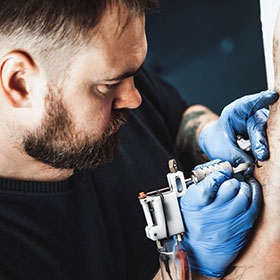Yes, face tattoos do hurt. The pain level varies by person.
Face tattoos are becoming more popular. Many people wonder about the pain involved. Tattoo needles puncture the skin. The face has many nerves and thin skin. This can make the process more painful. Pain tolerance differs from person to person.
Some describe it as sharp or stinging. Others feel a dull ache. Knowing what to expect can help you decide. This blog will discuss the pain of face tattoos in detail. We’ll explore why it hurts and what you can do to manage it. Stay with us to learn more.
Introduction To Face Tattoos
Face tattoos can be quite painful. The skin on the face is thin and sensitive, making the experience intense. Pain levels vary depending on the person’s pain threshold.
Popularity And Trends
Face tattoos are growing in popularity. Many celebrities have them. Fans follow this trend. These tattoos make a bold statement. They are very visible. This visibility attracts attention. Younger people especially like them. They see face tattoos as cool. Social media helps spread the trend. Photos and videos of face tattoos are common. This increases their popularity.
Cultural Significance
Face tattoos have deep cultural roots. Some cultures use them for rituals. They may show a person’s status or tribe. For some, they mean strength and bravery. Others use them for protection. Each tattoo can have a special meaning. It is more than just art. It is part of their identity. These traditions are passed down. They hold great value to many.
Pain Perception
Pain perception can vary from person to person. Some people feel pain more intensely. Others may have a higher tolerance. Face tattoos can be more painful than other tattoos. This is because the skin on the face is thin. The face has many nerve endings. These nerve endings can make it more sensitive.
A person’s pain threshold can affect how much they feel. Some may find face tattoos very painful. Others might not feel much pain at all. Factors like stress and sleep can influence pain. Being well-rested may help reduce pain. Staying calm can also help manage the pain better.
Anatomy Of The Face
The face has many sensitive areas. These areas include the eyes, nose, and lips. Thin skin and many nerves make these spots more painful. Tattoos here can hurt more than other places.
Skin near the eyes is very thin. This makes it sensitive. The nose has many nerves too. They send pain signals quickly. Lips are soft and delicate. This makes them hurt more when tattooed.
Bones are close to the skin on the face. Cheekbones, jaw, and forehead are examples. Tattooing near these bones can be more painful. The needle hits the bone area and causes more pain.
The cheekbone is very close to the skin. This makes tattooing here hurt more. The jaw is bony too. Tattoos on the jaw can be very painful. The forehead has a large bone area. Tattoos here can cause much pain.
Tattooing Techniques
Different needle types are used for tattoos. Round liners make fine lines. Round shaders fill in color. Magnum needles shade large areas. Needles affect pain levels. Smaller needles might hurt less. Larger needles can cause more pain.
The skill of the artist matters a lot. Experienced artists know how to minimize pain. They use the right pressure. Less experienced artists may cause more pain. Good technique is key. Always choose a skilled artist. This ensures a better experience. Ask for recommendations.
Pain Management
Topical anesthetics can help reduce the pain. These creams numb the skin. Apply them before getting a tattoo. They take about 30 minutes to start working. You can buy them over the counter. Ask a pharmacist for help if you need it. Some tattoo artists offer these creams too.
Proper breathing can manage pain. Breathe in slowly through your nose. Hold your breath for a few seconds. Then breathe out slowly through your mouth. This helps calm your body. It reduces the pain felt during the tattoo. Practice this before your tattoo session.
Post-tattoo Care
The healing process for face tattoos is very important. Keep the tattoo clean to avoid infection. Use a gentle soap and water. Pat dry with a clean towel.
Apply a thin layer of healing ointment. Repeat this step for a few days. Avoid direct sunlight and dirty environments. Do not scratch or pick at the tattoo. This can cause scarring or infection.
Some common issues include redness, swelling, and itching. These are normal and should go away in a few days. If you notice pus or extreme pain, contact your tattoo artist or a doctor.
Allergic reactions can also occur. Look for signs like rash or hives. In such cases, seek medical advice. Proper care ensures your face tattoo heals well. Enjoy your new art!
Psychological Factors
Being ready in your mind can help with face tattoo pain. Thinking about the process can lower fear. Knowing what to expect calms nerves. Feeling scared makes the pain worse.
High stress can increase the pain. Staying calm is key. Deep breaths help. Try to relax your body. Listen to music or talk with a friend. It can make a big difference.
Personal Stories
Many tattoo enthusiasts say face tattoos can hurt a lot. The skin on the face is thin. There are many nerves. This makes it more sensitive. Some people feel a sharp pain. Others say it feels like a burning sensation. Pain levels can vary greatly. Some find it unbearable. Others think it is just a mild discomfort. Pain tolerance is different for everyone.
Tattoo artists agree face tattoos can be painful. They suggest starting with a small design. This helps you understand your pain tolerance. Many artists use numbing creams. These can help reduce pain. Experienced artists work quickly. This can make the process less painful. Choosing the right artist is important. A good artist knows how to make you comfortable.
Conclusion
Face tattoos can be painful. Each person’s experience varies. Factors like location and pain tolerance matter. Choosing a skilled tattoo artist helps. Proper aftercare reduces discomfort. Consider long-term effects before deciding. Face tattoos are permanent. Weigh the pros and cons.
Make an informed choice. Always prioritize your comfort and safety.

